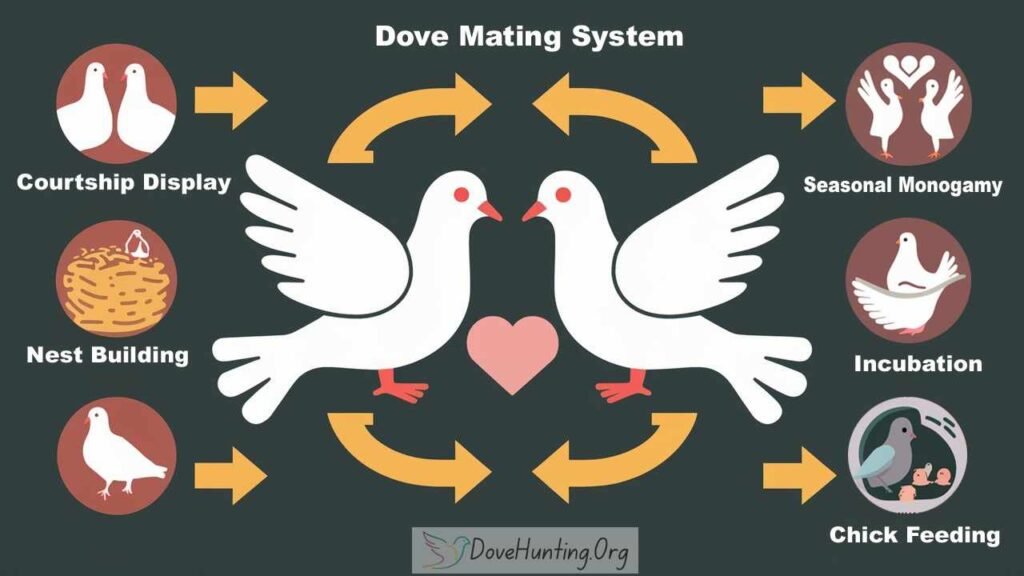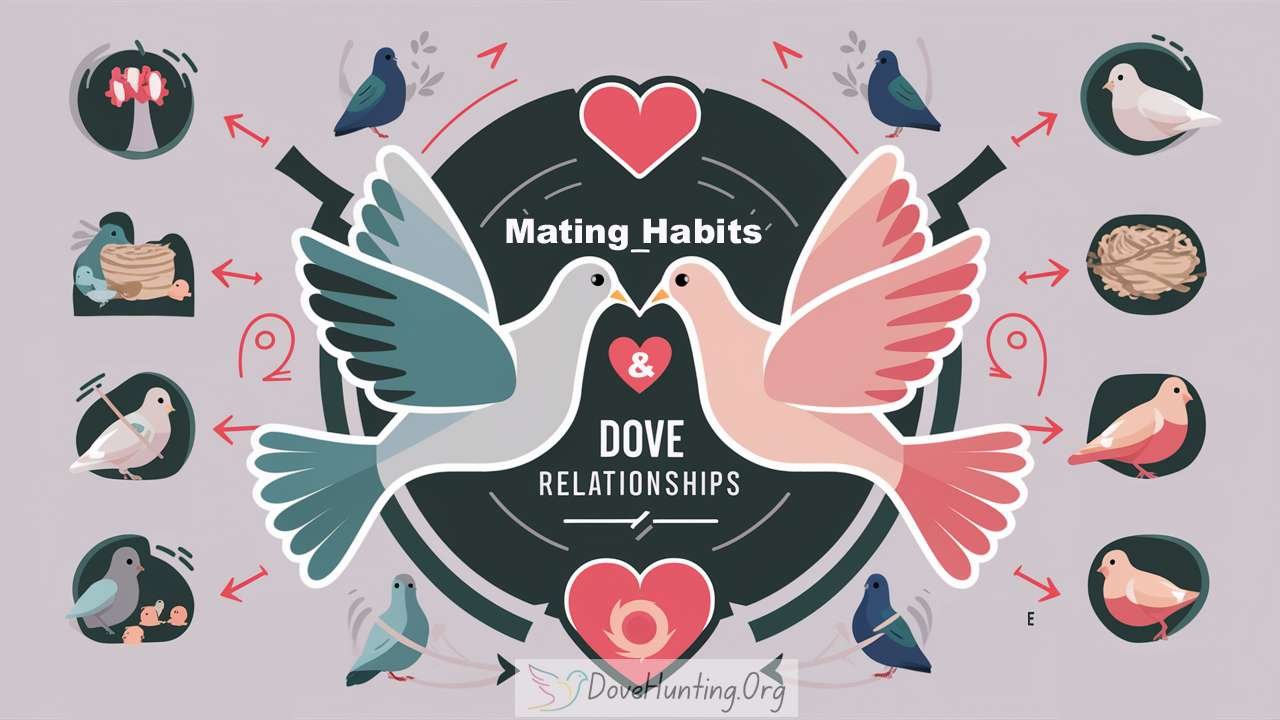Have you ever looked up at a overhead wire and noticed two doves gently cooing? Did you begin to ponder about their bond? It’s easy to wonder if these mild-mannered birds promise to be with just one partner forever. Yet nature often works in complex ways, and it’s no different for these doves. This piece takes a closer look at how doves mate. We’ll dive into their charming courtship methods, how they handle paternity, and the sentiments tied to these aviary romantics.
Not all types of doves stick together for eternity. Some doves may only pair up for a breeding season. But, a lot of dove species, including the famous Mourning Dove, bond strongly for a lifetime. They work as a solid team, where males impress females with extravagant gestures. Together they build nests, incubate eggs, and nurture the chicks. Teamwork helps their babies survive. It’s why we often think of doves as symbols of loyalty and love.
Understanding Dove Mating Habits
Doves follow a unique mating pattern called seasonal monogamy. For one breeding season, which may extend from spring to fall, they stick to one mate. Some doves, like the mourning dove, might have several families in a season. This makes their bond even stronger. Their way of raising young ones guarantees the future of their kids.
The importance of pair bonding in doves cannot be overstated. Working together as a team allows them to:
- Guarding their homes: Doves fiercely protect the places where they nest from anything that threatens them. A bond between them helps one dove stay on the lookout as the other finds food.
- Building a nest that’s safe: The two doves work together, with the female dove weaving together twigs and grass and the male bringing her things to use. They make sure their eggs have a well-hidden, sturdy home.
- Taking turns warming eggs: Each parent dove takes a turn keeping their eggs warm, which is really important for the little ones growing inside. It lets both doves get time to eat and take care of themselves.
- Raising their babies: After the eggs hatch, they work nonstop to feed the baby birds food they’ve chewed up. Both parent doves play a huge part in helping their babies grow and learn how to fly.
Dove Species and Mating Systems
Here’s a table summarizing the mating habits of different dove species:
| Dove Species | Pair Bonding | Broods per Season | Interesting Fact |
|---|---|---|---|
| Mourning Dove (Zenaida macroura) | Seasonal monogamy | Up to 6 | Often raises multiple broods in a single season |
| Rock Dove (Columba livia) | Monogamous pairs or loose colonies | Year-round | Can be found nesting in urban environments |
| Inca Dove (Columbina inca) | More solitary nester | Up to 4 | Primarily ground nesters |
| White-winged Dove (Zenaida asiatica) | Seasonal monogamy | Up to 4 | Known for their acrobatic courtship displays |

Springtime Sparks the Courtship
As spring comes, doves exhibit changes. Males turn more expressive. They start to coo softly and sadly to possible partners, a unique characteristic of mourning doves. Added to this, they put on stunning sky displays, confirming their superb flight skills with loud wing flaps and extended, sail-like descents. These dramatic acts are visual and sound spectacles aimed at winning a female’s notice.
Once a female dove responds positively, the male pursues his dance on the ground. He swells his chest, lowers his head, and coos with growing intent. This systematic conduct asserts his dominance and communicates his worthiness as a partner. The impressed female joins him, and together they commence the subsequent phase in their union – nest construction.
Raising Young Together
Dove parents show an amazing commitment to their young ones. With the nest ready, the mother lays a set of eggs, usually one or two. Mom and dad swap who warms the eggs over about two weeks. They make sure the eggs stay just the right temperature.
When the chicks hatch, they need their parents to live. Both male and female doves feed their chicks, again and again, passing up seeds and bugs. Working together as parents makes sure the little ones get food so they can grow and get their flying feathers. As the chicks get bigger, they don’t need to eat as often and they start to try out their wings.
Dove Parental Duties
This table highlights the shared responsibilities of dove parents:
| Duty | Description | Importance |
|---|---|---|
| Nest Building | The female takes the lead in weaving twigs, while the male gathers materials. | Provides a safe and secure environment for eggs. |
| Incubation | Both parents take turns keeping the eggs warm. | Ensures optimal temperature for embryo development. |
| Chick Feeding | Parents regurgitate seeds and insects to nourish the chicks. | Provides essential nutrients for chick growth and development. |
| Nest Defense | Both parents work together to ward off predators. | Protects vulnerable chicks from harm. |
Doves and Lifelong Partnership
The notion of doves pairing off forever has fascinated people for ages. Yet, it’s crucial to know the truth is more intricate. Although the bond between doves is robust and vital for making more baby doves, it doesn’t always endure. Things may cause doves to look for other mates:
- Separation or death of a mate: Doves, too, face nature’s tough side. When a dove’s mate dies or goes missing, it’s quite common for the lonely one to look for a new partner. This is their way of making sure that they continue to have offspring.
- Nesting troubles: Sometimes, doves might not be able to successful build a nest. Predators or other problems could upend their efforts. When the nest fails time and again, this could weaken their partnership. They may then try to find new mates, hoping for better success in breeding.
- Food shortages: When food is hard to come by, a dove might choose to look for a partner in a land where there’s more food. This could lead to the end of a current partnership.
Even with some unusual cases, a dove’s loyalty to its mate in the breeding period is impressive. They show lots of joint effort in creating nests, warming eggs, and raising little ones. This points out how working together helps their little ones stay alive.
Conclusion
Doves are cool! The quiet hum of doves reveals a mystery about bird bonds. The “forever partner” idea isn’t always right, but they stick close during breeding. They never stop working together to make nests, warm eggs, and look after their babies. It’s impressive to see such teamwork and care from parents.
Two doves side by side often stand for love, calmness, and loyalty. People connect with these soft birds and the ideals they signify. But, it’s not so simple. The way doves mate shows that nature is not just one thing or the other. Doves are flexible. Depending on what’s happening around them, how they behave can change.

